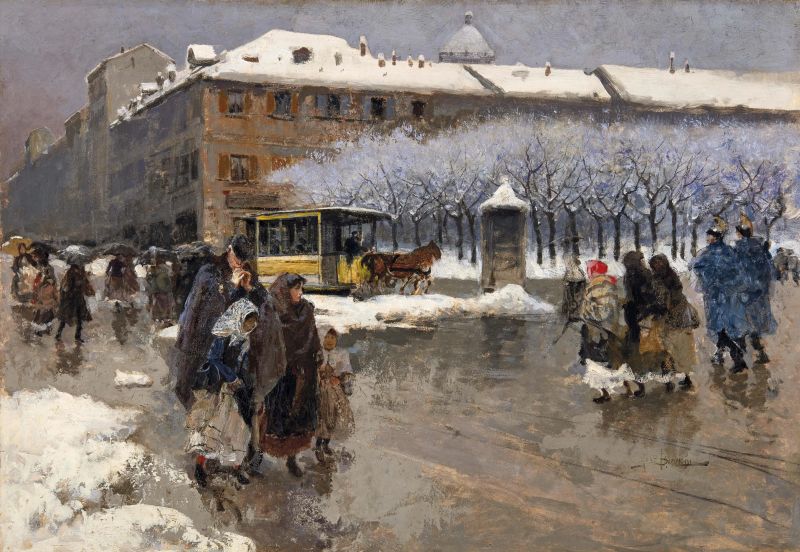Mosè Bianchi
(Monza 1840 - 1904)
OLD MILAN
oil on cardboard, cm 53,5x77
signed lower right
Exhibitions
Maestri dell'800 italiano, Galleria Sacerdoti, Milan, 20 November-22 December 1971
Literature
Maestri dell'800 italiano, exh. cat. (Galleria Sacerdoti, Milan, 20 November-22 December 1971), Milano 1971, s.p.
Mosè Bianchi, a Verist painter in the strictest sense of the word, was one of the most famous Italian artists of the 19th century; his notoriety accompanied him even abroad, thanks to Maison Goupil, which handled the most prominent painters of the time.
A stay in Paris in the 1860s infused the works of this painter from Monza with that vital impulse that permitted him to broaden the horizons of Lombard Naturalism, an anti-academic current that arose primarily from a deeply-felt need to re-establish a contact with everyday reality.
Adhesion to the ‘real’, one of the dominant motifs in the artist’s pictorial creations in the Eighties, is accentuated by his palette, chosen to faithfully represent the atmospheres of the city.
The work presented here falls within the production of those years and stands in coherent relation to his other works of the time, which explore many facets of the same theme. It is one of his most specifically realistic views of the city of Milan, in which the artist reveals Impressionistic leanings with a vibrant brushstroke and a strong compositive structure. Snow is a subject especially congenial to this painter, as he himself mentioned in several letters to friends, since it allowed him to paint moments in which the city takes on an intense atmospheric and chromatic unity.
The quality of this representation of a ‘slice’ of city life is also expressed in the equipoise achieved by the composition, in the balanced ratios of full and empty spaces, of buildings and open areas; the background architecture melds into the grey of the cloudy sky, while the bustling figures on the sidewalks, braving the winter cold, appear as coloured silhouettes in the urban landscape of which they are integral parts. One very interesting note is lent by the background portrayal of a yellow horse-drawn tram, a means of transportation introduced to the city only a few years before: Milan’s first animal-powered urban tramways were inaugurated on 11 April 1881 on occasion of the great Esposizione Industriale Nazionale. The lines, managed by the Società Anonima degli Omnibus, were laid out in a radial pattern with a single central terminus in Piazza del Duomo and ran to the city’s gates.
The painting emerges favourably from comparison with other, analogous views of the same corner of Milan dating to the period from 1885 ca. to the end of the century’s ninth decade; the painter returned to it numerous times, thanks in part to the support offered by the photo camera. Of note among these works are Neve a Milano, in a private collection, and Una nevicata a Milano, in Milan’s Galleria d’Arte Moderna (P. Biscottini, Mosè Bianchi. Catalogo ragionato. Milan, 1996, pp. 285 nos. 382, 352, 549), which references our painting in the unexpected red spark of the hood of a figure hurrying away, on the right, although the work presented here is much richer in figures and anecdotal suggestions.










